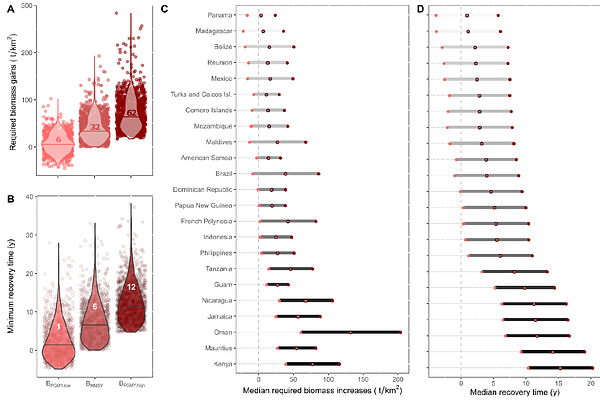Potential yield and food provisioning gains from rebuilding the worlds coral reef fish stocks

Potential yield and food provisioning gains from rebuilding the worlds coral reef fish stocks
Zamborain-Mason, J.; Cinner, J. E.; MacNeil, M. A.; Beger, M.; Booth, D.; Ferse, S. C. A.; Golden, C. D.; Graham, N. A.; Hoey, A. S.; Moulliot, D.; Connolly, S. R.
AbstractMany coral reefs have fish stocks that are depleted below the level at which sustainable production is maximized. Lower production means that millions of people are losing out on potential food, income and livelihoods. Rebuilding these stocks to maximize sustainable production can contribute towards ending hunger and malnutrition but requires active and effective fisheries management. Yet, for fish stock recovery plans to be implemented, recovery benefits, targets and timeframes need to be quantified. Here, using 1211 individual reef sites and 23 jurisdictions identified globally as being below maximum sustainable production levels, we show that reefs have the potential to increase sustainable yields by nearly 50% if allowed to recover towards their maximum production levels. For individual jurisdictions this recovery represents from 20,000 up to 162 million additional sustainable servings of reef fish per year in comparison to current sustainable production, meeting recommended seafood intake for up to 1. 4 million additional people a year. However, such growth and food provisioning will require fish stocks to double their standing biomass (increase by a median of 32 t/km2). Recovery timeframes range from 6.4 years under the most stringent scenario (a seascape moratorium) to 49.7 years under the maximum harvest scenario that results in recovery. We find that locations with the greatest potential for sustainable gains in yield are among those with the greatest food and micronutrient deficiencies, underscoring both the challenges and opportunities in recovering fish assemblages to achieve their maximum sustainable potential.